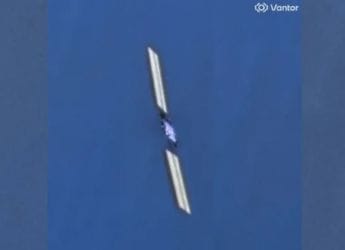- Home
- Wearables
- Wearables News
- Microsoft Launches HoloLens 2 Development Edition; Unveils IoT Plug and Play Modelling Language
Microsoft Launches HoloLens 2 Development Edition; Unveils IoT Plug and Play Modelling Language
Microsoft claims that its Mixed Reality Developer Program has attracted more than 20,000 developers over the past year.

Microsoft HoloLens 2 Development Edition is being available for developers at $3,500 or $99 per month
Just days ahead of Microsoft Build 2019, the Redmond company has announced the HoloLens 2 Development Edition. The new move is targeted to enhance mixed reality (MR) developments, and it comes as an expansion of Microsoft's Mixed Reality Developer Program that is touted to have attracted more than 20,000 developers over the past year. Microsoft has also revealed that there are 54 Azure regions across the globe and over 1.3 million developers are using Azure Cognitive Services -- developing nearly 3,000 new bots each week.
The HoloLens 2 Development Edition is being provided to developers through the Mixed Reality Developer Programme. It can be availed at $3,500 (roughly Rs. 2,43,000) or $99 (roughly Rs. 6,900) per month and includes $500 (roughly Rs. 34,700) Azure credits and three-month free trials of Unity Pro and Unity PiXYZ Plugin for CAD data.
To recall, Microsoft unveiled the HoloLens 2 to the world at the Mobile World Congress (MWC) 2019 tradeshow in Barcelona back in February. The hardware of the regular HoloLens 2 is identical to its Development Edition, though the Azure and Unity benefits are specifically provided for developers building new MR solutions.
The HoloLens 2 has a diagonal field-of-view stands of 52 degrees, with maintaining the holographic density of 47 pixels per degree of sight. Microsoft has used its microelectromechanical system (MEMS) display technology that is claimed to offer the equivalent of a 2K display for each eye. Under the hood, there is a Qualcomm Snapdragon 850 SoC -- alongside a custom-built Holographic Processing Unit.
"Bringing together HoloLens 2, Azure Mixed Reality Services, and Unity Pro, the most widely used real-time 3D development platform, makes it easy for developers to create professional mixed reality experiences using your industrial design data. The PiXYZ plugin gives you the tools to create real-time experiences using Computer Aided Drawing (CAD) or Building Information Management (BIM) data," said Julia White, Corporate Vice President, Microsoft Azure, in a blog post.
Microsoft has also announced Unreal Engine 4 support for streaming and native platform integration for the HoloLens 2 smartglasses. Developers will be able to start using Unreal Engine 4 by the end of May.
Alongside the new offerings towards the MR world, Microsoft has brought its Internet of Things (IoT) centred IoT Plug and Play open modelling language. This is designed to connect IoT devices to the cloud and let developers build new experiences "without having to write a single line of embedded code" at their end. The IoT Plug and Play works similar to the Plug and Play technology powering PC users to quickly connect peripherals -- without manually installing their drivers.
Microsoft has tied up with partners such as Compal, Kyocera, and STMicroelectronics to bring the initial list of devices leveraging IoT Plug and Play. Moreover, developers can find IoT Plug and Play enabled devices through the Azure IoT Device Catalogue to expand their connected device developments.
To offer developers with data security and analytics on the edge, Microsoft has introduced the preview of Azure SQL Database Edge. The new solution is touted to provide a SQL engine that works just as Azure SQL Database and SQL Server. It supports ARM and x64-based interactive devices and edge gateways and has the ability to build apps that can work across Azure SQL Data and SQL Server on premises as well as Azure SQL Database Edge. Furthermore, there is support for business intelligence through Microsoft Power BI and other business intelligence tools.
Microsoft has also expanded its Cognitive Services to make AI more communicable for developers. There is a Cognitive Service category called Decision that is aimed to offer a specific recommendation for more informed and efficient decision making than earlier. The category includes Content Moderator and Anomaly Detector. Also, there is a new service called Personaliser that provide users with a specific recommendation to enable quick and informed decision-making.
For developers exploring ways to uplift Cognitive Services algorithms by searching through structured and unstructured content, Microsoft has kicked off the general availability of the cognitive search capability within Azure Search. Developers can also store AI insights they've gained from cognitive search to create knowledge-rich experiences.
It is significant to point out that Microsoft claims over 1.3 million developers using its Azure Cognitive Services to build intelligent apps that can see, hear, speak, and understand. Similarly, nearly 400,000 digital agents aka bots have been built so far using the Azure bot service and more than 3,000 join the board each week.
For Blockchain-specific developments, Microsoft has announced Azure Blockchain service. This new development uses a fully managed consortium network and provides built-in governance for common management tasks, including adding new members, setting permissions and authenticating user applications.
Notably, JP Morgan's Ethereum platform, Quorum, has emerged as the first ledger available in Azure Blockchain Service. The service is currently available in preview.
Microsoft is also improving its Azure Machine Learning platform with MLOps capabilities, automated ML advancements, and visual machine learning interface. Additionally, the company has announced the general availability of hardware-accelerated models that run on FPGAs. It has also announced ONNX Runtime support for Nvidia TensorRT and Intel nGraph to support high-speed inferencing on Nvidia and Intel chips.
Get your daily dose of tech news, reviews, and insights, in under 80 characters on Gadgets 360 Turbo. Connect with fellow tech lovers on our Forum. Follow us on X, Facebook, WhatsApp, Threads and Google News for instant updates. Catch all the action on our YouTube channel.
- Samsung Galaxy Unpacked 2025
- ChatGPT
- Redmi Note 14 Pro+
- iPhone 16
- Apple Vision Pro
- Oneplus 12
- OnePlus Nord CE 3 Lite 5G
- iPhone 13
- Xiaomi 14 Pro
- Oppo Find N3
- Tecno Spark Go (2023)
- Realme V30
- Best Phones Under 25000
- Samsung Galaxy S24 Series
- Cryptocurrency
- iQoo 12
- Samsung Galaxy S24 Ultra
- Giottus
- Samsung Galaxy Z Flip 5
- Apple 'Scary Fast'
- Housefull 5
- GoPro Hero 12 Black Review
- Invincible Season 2
- JioGlass
- HD Ready TV
- Laptop Under 50000
- Smartwatch Under 10000
- Latest Mobile Phones
- Compare Phones
- Huawei Nova 15
- Huawei Nova 15 Pro
- Huawei Nova 15 Ultra
- OnePlus 15R
- Realme Narzo 90x 5G
- Realme Narzo 90 5G
- Vivo S50 Pro Mini
- Vivo S50
- Asus ProArt P16
- MacBook Pro 14-inch (M5, 2025)
- Huawei MatePad 11.5 (2026)
- OnePlus Pad Go 2 (5G)
- Huawei Watch 10th Anniversary Edition
- OnePlus Watch Lite
- Acerpure Nitro Z Series 100-inch QLED TV
- Samsung 43 Inch LED Ultra HD (4K) Smart TV (UA43UE81AFULXL)
- Asus ROG Ally
- Nintendo Switch Lite
- Haier 1.6 Ton 5 Star Inverter Split AC (HSU19G-MZAID5BN-INV)
- Haier 1.6 Ton 5 Star Inverter Split AC (HSU19G-MZAIM5BN-INV)












